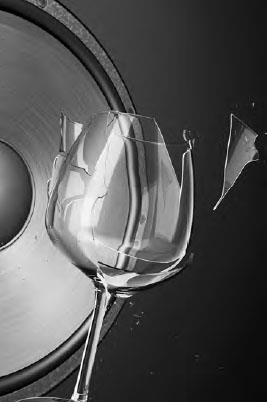WavesResonance |
How can resonance cause crystal glasses to break? |
Many years ago Ella Fitzgerald performed a physics experiment in an advertisement for Memorex® audio tape cassettes. The company claimed that the famous singer could create a pure tone at just the right frequency to cause a crystal wine glass to break and that the Memorex® tapes recorded and played back sounds so accurately that the glass would break both when Ms. Fitzgerald sang and when the recorded sound was played. “Is it live or is it Memorex®?” was the advertising question.
Although it is hard to think that glass is something that can bend, if you tap the rim of a thin wine glass you can hear it “ping.” The shape of the rim of the glass oscillates. When the amplified sound waves pushed on the glass it distorted its shape. Some of the kinetic energy in the sound wave was transferred into the kinetic energy of the oscillating glass. When the frequency of the sound wave matched the natural frequency of the glass the amplitude of oscillation was large enough to shatter the glass.

